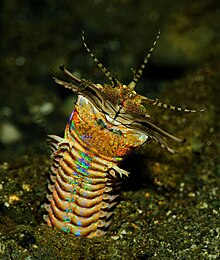Eunice aphroditois
| Eunice aphroditois | |
|---|---|
 |
|
| Scientific classification | |
| Kingdom: | Animalia |
| Phylum: | Annelida |
| Class: | Polychaeta |
| Order: | Eunicida |
| Family: | Eunicidae |
| Genus: | Eunice |
| Species: | E. aphroditois |
| Binomial name | |
|
Eunice aphroditois Pallas, 1788 |
|
Eunice aphroditois (colloquially known as the Bobbit(t) worm) is an aquatic predatory polychaete worm dwelling at the ocean floor. An ambush predator, the animal buries its long body into an ocean bed composed of gravel, mud, or corals, where it waits for a stimulus to one of its five antennae, attacking when it senses prey. Armed with sharp teeth, it is known to attack with such speed that its prey is sometimes sliced in half.
Eunicids inject a toxin into their prey, which stuns or kills it, such that prey much larger than the worm itself can be eaten and digested. Another family of polychaete worms, the fireworms (Amphinomidae), have harpoon-shaped chaetae (bristles) that release a toxin that can cause severe skin irritation, but in E. aphroditois, the chaetae are used only for grip when crawling over sediment.
Little is known about the sexual habits and lifespan of this worm, but researchers hypothesize that sexual reproduction starts at an early stage, maybe even when the worm is about 100 mm (4 in) in length; this is very early, considering these worms can grow to sizes of nearly 3 m (10 ft) in some cases (although most observations point to a much lower average length of 1 m (3 ft 3 in) and an average of 25 mm (1 in) in diameter).
E. aphroditois is found in warmer oceans around the world, including the Indo-Pacific and Atlantic.
Bobbit worms may be accidentally introduced into artificial environments. In March 2009, the Blue Reef Aquarium in Newquay, Cornwall, discovered a Bobbit worm in one of their tanks. The workers had seen the devastation caused by the worm, such as fish being injured or disappearing and coral being sliced in half, but did not find it until they started taking the display apart in the tank. The worm was nicknamed "Barry".
...
Wikipedia
